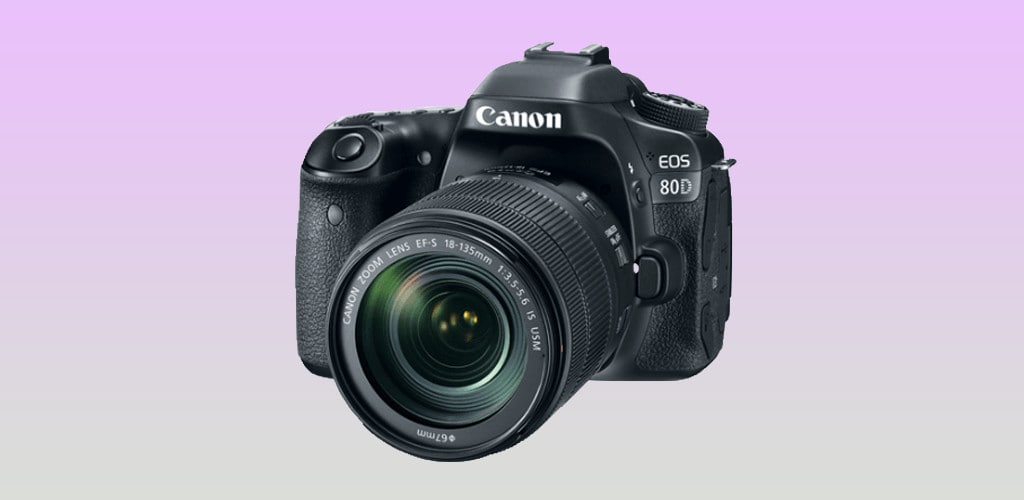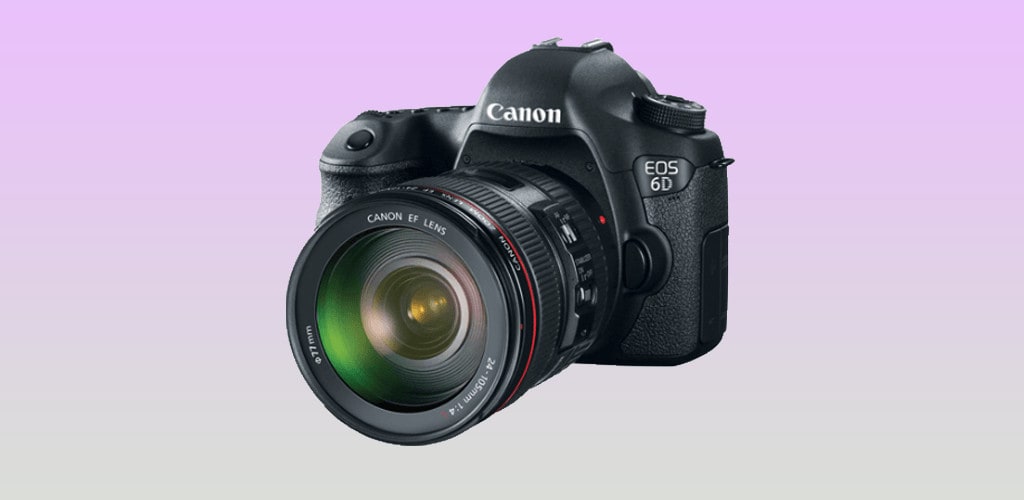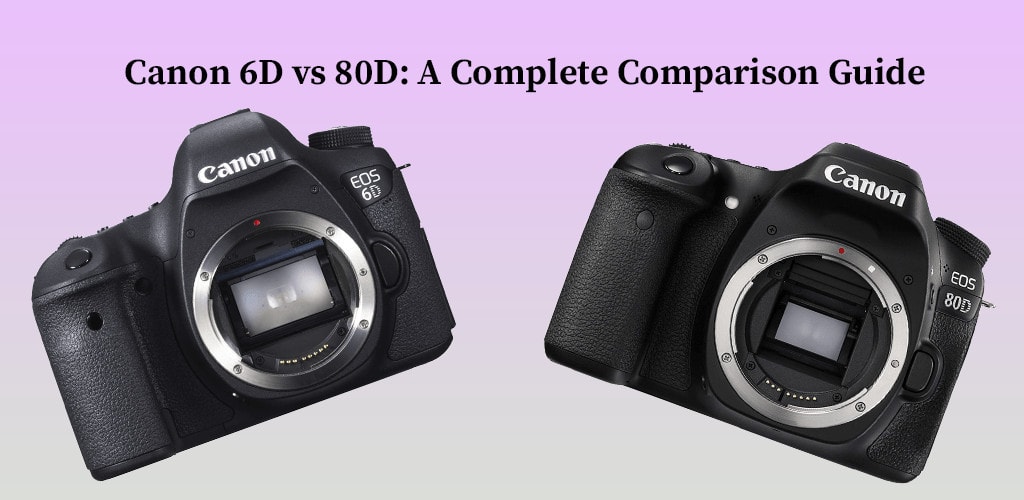Can’t choose which camera from Canon is better?
To help you decipher, we’ve decided to do a face-off between the two advanced cameras released by Canon: Canon EOS 80D VS Canon EOS 6D.
We’ll delve into the best features, specs, and our favorite qualities of each camera.
Let’s go!

Canon EOS 80D
24 MP (APS-C Sensor) | 326 lenses, Canon EF/S-Mount

Canon EOS 6D
20 MP (Full Frame Sensor)| 250 lenses, Canon EF
Similarities
Before we look at the differences, let’s quickly look at the notable similarities of these Canon cameras that make them CROWD FAVORITES.
Wide Screen Size
The 3” screen of the Canon 6D and Canon EOS 80D complements the camera features available.
Both Canon LCDs also have the same 1040k-dot resolution which enables better precision in setting high or low composition. It also provides better visibility even in strong sunny environments!
Storage
Both cameras process and store their files in SDXC cards. Plus, Canon designed both in such a way that these can use UHS-I cards. This only means: Ultra High-Speed data transfer.
You’ll reach the perfect frame even during daylight. You won’t have to worry about the sun messing up the frame as both have an eye-level viewfinder.
Videographers find the on-sensor phase detect highly useful as this enhances live view and video autofocus performance.
Aperture priority
Present in both Canon cameras which comes handy when there is a need to control the focus of objects in the frame.
Full HD
Both cameras sport a 1920 x 1080 video resolution!
Ultimate connectivity
This is something to expect from these cameras. Both have a remote control, are wi-fi enabled, and HDMI compatible.
If you need easy and instant access to your photos and videos using your smartphone, you can rely on these cameras.
Other Similarities
Aside from these features, both Canon cameras sport a top deck display, pentaprism, hot shoe mounting point, and a bulb shutter.
Both are also heavy-duty cameras: splash and dust-proof. Canon fortified the exterior with a weather-sealed body which means they can withstand harsh environments or inclement weather.
Canon EOS 80D vs Canon EOS 6D: An In-Depth Comparison
Now, it’s time to take a closer look at these two.
In terms of release year, Canon EOS 6D has seniority as it was released back in 2013. Three years later, the Canon EOS 80D was introduced to the public.
Although these have been in the market for years, until now, these Canon cameras are still considered advanced DSLR cameras for their versatility and features.
Needless to say, the determining factors lie beyond the year when Canon released both gadgets.
From a quick glance, both look identical but beyond the surface, the two options are very different cameras.
To get a clearer picture (pun intended), we’ll look at 4 major aspects of these cameras from Canon:
- Exterior or Physical Body
- Sensor
- Lenses
- Extra Features
Reminder: Do note that both the Canon EOS 80D and 6D Canon production have been discontinued. The 6D Canon camera has been replaced by the Canon EOS 6D Mark II, while Canon EOS 80D has a later version which is the Canon 90D.
Physical
At a glance, the Canon EOS 80D is more compact than the Canon EOS 6D.
The smaller dimensions of the Canon EOS 80D also give it an advantage when it comes to weight as it is lighter by roughly 25 grams.
- Canon 6D: 755 g, 145 x 111 x 71 mm
- Canon EOS 80D: 730 g, 139 x 105 x 79 mm
However, size and weight should be considered alongside the camera’s compatibility with interchangeable lenses you plan to use.
For example, heavier lenses would be supported by a bigger base and larger imaging sensor- in this case, the Canon EOS 6D. The smaller sensor camera (Canon 80D) would go well with more compact lenses.
Screen
Another factor that can tip the scale would be the screens.
Canon EOS 6D has a conventional panel while the Canon EOS 80D camera has a touch-sensitive screen.
It may not be an issue for some, but touchscreen features can be useful when setting the focus. You’ll have better control of this in-touch screens compared to conventional panels.
Moreover, the screen of the Canon 80D can be fully articulated or rotated until it becomes a front-facing screen. This flip-out screen would also come in handy during tricky shots.
Vloggers or those who like to take selfies would totally appreciate this feature.
For those who put a premium on flexibility, the clear winner would be Canon EOS 80D.
Battery Life
When talking about battery life, bigger might be better.
- When comparing fully charged Canon 80D and 65 Canon camera, the LP-E6 battery of the 6D Canon can take 1,090 photos.
- Meanwhile, Canon EOS 80D can process up to 960 images with its LP-E6N power pack.
Better battery: Canon EOS 6D
News Flash
It’s also important to point out that both gadgets have an external flash. However, only the Canon 80D has a built-in flash.
The max flash sync of the Canon 80D is also faster, with a rate of 1/250s versus the 1/180s of the Canon 6D.
The flash component definitely supports the sensors of the camera – which we’ll look into in the next section.
Sensor
The next thing we’ll analyze is one of the CRUCIAL factors to consider when buying a camera – SENSORS.
An important aspect to consider when buying a camera would be IMAGE QUALITY, and Canon seems to have mastered this.
When it comes to sensor area, size matters.
You’ll be able to tell this by checking the size of the imaging sensor. Larger sensors would be responsible for better quality photos – delivering clear, crisp, quality shots.
Canon EOS 6D
- full-frame sensor
- sensor size: 24 mm x36 mm
Canon EOS 80D
- APS-C sensor
- sensor size: 15 mm x 22.50 mm
If this is the only factor you want to consider, go for the 6D Canon camera as it has large full-frame sensors. APS-C Sensor is about 60% smaller than the full-frame sensor of Canon 6D.
An advantage of full-frame sensors is they can produce bigger individual pixel units which result in better resolution.
In this case, a full-frame sensor can produce:
- Larger pixel-unit with better low-light sensitivity
- Richer depth of its colors
- Wider dynamic range than the APS-C sensor
Another edge of Canon’s full-frame large sensors: Versus the APS-C, the Full Frame increases the chances to utilize shallow depth-of-field, allowing the photographer to single out or isolate a subject from its background.
What This Means Is…
If two cameras were to shoot from the same focal length and aperture, the bigger sensor would allow more control on the field depth, resulting in a better focus of the subject by creating a blurry background.
However, there are OTHER factors that contribute to the quality of the captured image.
What About the Canon 80D?
Don’t be fooled by the size of the APS C sensor. Although smaller than the full-frame sensor of the 6D Canon, the APS C Sensor of Canon 80D is supported by a more advanced image processing engine.
The DIGIC 6 of the Canon 80D features better color accuracy, faster processing speed, and noise reduction capability.
Canon 6D may have bigger sensors, but it’s a tie for us in this category.
Megapixel
The 24.0 megapixels (APS C) of the Canon EOS 80D offer higher resolution, in contrast to Canon 6D which only has 20 megapixels.
Megapixels ultimately come in handy when zooming in or resizing the picture.
For example, if you need to print larger copies or crop the photo, the quality of the image isn’t compromised if the photo has higher megapixels.
ISO Sensitivity Range
Comparing the Native Sensitivity Range, Canon 6D is superior to Canon 80D.
For beginners, ISO basically adjusts your camera’s sensitivity to light. This becomes useful when shooting in darker environments.
- ISO Settings for Canon 80D are ISO 100 to ISO 16,000 – which can be extended up to 100-25,600.
- Canon 6D settings are ISO 100 to ISO 25,600 – which may be increased to 50-102,400.
DXOMark Sensor Scores
You’ve probably heard about DXOMARK Sensor evaluation or scores. When reviewing camera options, it would be good to check the scores in order to get a more quantified rating on the camera.
The score is based on the image quality produced by the camera sensors when taking images in RAW format.
It is a reliable evaluation as it is based on lab testing, and it analyzes images before any edits or JPG processing takes place.
In addition to the overall score, they also rate the camera’s color depth (DXO Portrait), low-light sensitivity (DXO Sports), and dynamic range (DXO Landscape).
As the two cameras are advanced DSLRs from Canon, it comes as no surprise that they fared well in terms of their DXO marks.
Canon 6D:
- Color depth: 23.8 bits
- Sensitivity in low-light: 2340 ISO
- Dynamic range: 12.1 Evs
Canon 80D:
- Color depth: 23.6 bits
- Sensitivity in low-light: 1135 ISO
- Dynamic range: 13.2 Evs
However, between these two cameras – 6D Canon and Canon 80D – the former garnered a higher overall score.
The Canon 80D scored a higher dynamic range (DO Landscape) but lower in color depth. However, the difference in these aspects is minimal.
The dynamic range and color depth were close but the main contributor to the higher grade of Canon EOS 6D is the low-light aspect.
In summary, Canon 6D can produce better quality photos even with minimal light available.
Lenses
In addition to image quality, another factor to consider would be the LENSES.
Let’s now look at the specs and compare the lenses of Canon 6D and Canon EOS 80D.
The latter offers more powerful lenses. It has 326 lenses for Canon EOS 80D’s Canon EF/EF-S mount. Meanwhile, 6D Canon only has 250 lenses for Canon EF lens mount.
Focus Points
A big gap we noticed was in terms of focus points. Canon EOS 80D brags a score of 45 while the 6D Canon only offers 11 focus points.
This can be useful in sports or live-action photography.
Image Stabilization
Although these are advanced options, do note that these Canon gadgets both lack image stabilization. This means that they do not have a sensor-based image stabilization built-in the camera.
However, you can separately purchase lenses with this feature.
Other Features
Video Capturing
It wouldn’t be considered advanced if the camera can’t capture video footage as well.
What’s impressive about both the 6D Canon camera and Canon EOS 80D is they are equipped with sensors with read-out speed that is fast enough to capture moving pictures.
Between the two, Canon 80D has a clear advantage over the 6D Canon camera as it has a faster frame rate.
Movie footage can be shot at 1080/60p with the Canon EOS 80D. On the other hand, although still above average, the Canon 6D can only record at 1080/30p.
Optical Viewfinder
The optical viewfinder comes in handy when framing an image in a brightly lit location.
In terms of field of view, Canon 80D has a wider viewfinder coverage. Canon EOS 80D has a 100% while the 6D Canon camera comes at 97%. The 3% difference affects the visibility in the finder.
Canon EOS 6D makes it up by having a higher viewfinder magnification (0.71x vs 0.59x) – which is astounding!
The image seen in the finder is very close to what is seen with the human eye.
Shutter Flaps & Continuous Shooting
Action shots, anyone?
For photographers needing continuous shooting for live, fast-moving shots, this would boil down to the camera’s Frames Per Second.
In this category, Canon 80D again bags the top spot. 6D offers 4.5 FPS while Canon EOS 80D has a shutter speed of 7 flaps per second.
Moreover, it might help to note that the Canon 80D can capture time-lapse sequences through its built-in intervalometer.
You can capture the sunrise, rush hour, or a caterpillar turning into a butterfly without the need to buy external camera triggers or software.
Connectivity
Which camera offers better connectivity?
Although both have an external microphone for audio clarity, it might not be enough if you require rigorous audio monitoring.
If you need the camera mainly for video purposes, you’ll be better off with the Canon 80D as it has a headphone jack.
This allows you to connect external headphones to monitor the quality of the audio recording during the process.
It would be a bummer to finish a 30-minute video recording only to realize the sound is unclear or has a lot of background noise, right?
Geolocation
For landscape photographers, this GPS feature from Canon is a sweet touch.
Canon 6D has an internal geolocalization sensor which means you can record and locate the GPS coordinates in the EXIF data. This feature is not present in the Canon 80D.
Other Good to Haves:
Canon EOS 80D
- Built-In Flash: Yes
- Near Field Communication: Yes
- Sensor Pixel Area: 14.06µm2
- Built-in Bluetooth: No
Canon EOS 6D:
- Built-In Flash: No
- Near Field Communication: No
- Sensor Pixel Area: 43.29µm2
- Built-in Bluetooth: Yes
Summary Of Strengths
It can be quite overwhelming to process all this information, especially when there are multiple strengths present in one camera while lacking in the other.
Here is an overview of our top favorite qualities for each Canon camera:
Favorite Qualities of the Canon EOS 6D:
- Geolocation Feature
- Better low-light processing, which would require less light to capture good quality photos
- Full frame sensor
- Quality 250 lenses for Canon EF lens mount
- Good battery life!
This is our camera recommendation for those who plan to shoot in open or remote locations (deserts, forests, caves).
Longer battery life and the ability to capture good photos even in a low-light setting would definitely come in handy.
Plus, you can always backtrack the location with GPS data!
Favorite Qualities of Canon EOS 80D
- Higher sensor resolution (24 MP APS C) and FPS!
- POWERFUL 326 lenses for Canon EF/EF-S mount
- More techy option: touchscreen, headphone jacks, swivel screen capability
- Larger field of view and better live view focus
- Better performance in terms of shutter speed, burst speed, device pairing connectivity
- Time-lapse photography!
The Canon EOS 80D will be perfect for amateur and professional photographers alike.
The easy-to-use and reliable APS C sensor make the Canon 80D a solid investment. Not to mention the advanced video recording features that can be useful for photos and reels.
As it has been released 3 years after the Canon EOS 6D, it has more innovative features and technical progress embedded in the design of the camera.
Needless to say, whether you choose the Canon EOS 6D or Canon 80D, either one would be worth your buck. Ultimately, it all boils down to preference and if you have a more specific purpose for the camera.
Verdict: Which One Is Better – Canon EOS 6D VS Canon EOS 80D?
That ends our review on the Canon 80D and Canon EOS 6D!
If we compare both – Canon 6D is still a reliable option today, BUT the Canon 80D has clearly benefited from the technological advancements made in the 3 year gap period.
The overall specs and features of the Canon EOS 80D would generally deliver the better image quality and raw video clips.
We hope this review helped you determine which camera is perfect for you!



